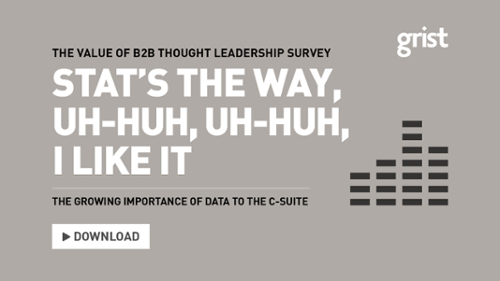Once upon a time, thought leadership was a brand-awareness exercise. It was something you invested in to get your name and logo on a report that would be passed around and read by the wider industry, by prospects and clients alike. It was a thing of prestige, a big-ticket item you might do once a year or even less.
And then came along the need to be found on search engines, followed by changes to SEO algorithms focusing on content quality, and then wide-ranging content marketing strategies and that all-encompassing need to feed the content beast to remain relevant and in the thoughts of your client base.
These peripheral changes to how words are handled by marketing teams have had a knock-on effect in the thought leadership realm, moving it from that brand-building territory into a much more commercially-driven exercise. Thought leadership is now about growing businesses, not just getting the name out there.But, even if the KPIs have changed, it’s important not to lose what thought leadership is about. It is designed to show that a company deeply understands its business, the needs of its clients, and the broader marketplace in which it operates.
Thought leadership needs to be leading thought
At a roundtable session in London late last year, we gave a select group of seasoned B2B marketers an early peek into the findings from our newly-released Value of Thought Leadership Survey. The discussion was wide-ranging, covering whose views the C-suite want to hear to the need for robust and reliable data to back-up and add credibility to thought leadership. However, one thought sparked much debate: how to keep the thought leadership aspect while addressing the commercial needs of business.
Much of what passes as thought leadership these days is content for content’s sake. It’s just something to push out and send to prospects rather than trying to generate discussion or move the industry forward. Believing thought leadership is not important, though, can be a costly mistake. Bad thought leadership can be worse for your brand than no thought leadership at all. According to our survey, a lack of original insights or ideas is one of the biggest audience turn-offs.
“A lot of thought leadership out there is not great. It’s treated more as an FYI rather than something to base a decision on,” said one attendee. Agreed another: “Many people have had a go at thought leadership, but they’re really only just scratching the surface. I find most content labelled as ‘thought leadership’ is actually just guff. It’s not useful or new.”
One participant noted the issue of oversaturation in the market – that there’s too much “thought leadership” out there, and that brands must make content that’s valuable to cut through the noise.
True thought leadership – the sort that engenders discussion and moves the needle – has become a core differentiator in a crowded market. It must say something new or be genuinely useful in some way, or it will be ignored, relegated to that guff-heap.
Driving business goals with thought leadership
So how can a company move its efforts from content to true thought leadership? Nicole Revers of global M&A advisor SI Partners presented to the roundtable their thought leadership programme, The Path to Growth Survey, which shared insights into growth opportunities for marcomms agencies after surveying 600 marcoms agencies in every major national and regional market.
Working in a very niche market of marcomms agency leaders, and on a global basis, SI Partners found it difficult historically to get a complete picture of the market. Nicole commissioned a survey of 600 agency leaders across 14 global locations. The result was one global report, five country-specific standalone chapters and a bonus “buyer/seller disconnect” special report.
Downloads of the report generated new marketing qualified leads and the data helped the sales team to spark conversations, strengthen pitches and host events around the world. In short, this statistically robust, data-led thought leadership was created with a commercial imperative, and has driven qualified leads to the business.
Nicole did speak about the difficulty of getting buy-in for her programme, something many roundtable participants also found. This is where the commercial imperative becomes the selling point. By tying your thought leadership programme into business strategy and KPIs – showing it’s not just “another bit of content” and bringing in examples of how other companies have had tangible outcomes from thought leadership – the board will be more likely to see that it’s about growing the business, not just putting the logo on a shiny piece of paper.
If you’d like to be invited to our next roundtable discussion, or would like to hear more about our C-suite research, contact Somaya Bahoussain, somaya@gristonline.com.



